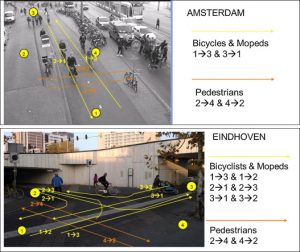This study used video observations of cyclists and moped riders on busy cycle paths in Amsterdam and Eindhoven. It is noted that previous research has shown that about three-quarters of cyclists hospitalized by a crash were not involved with a motor vehicle. 62% were involved in a single-bicycle crash and an additional 12% crashed with another bicycle. As cycle paths become more busy with a wide variety of bikes, ebikes and light mopeds safety becomes an increasing concern.
CCTV video was recorded as series of jpeg images. Initially, traffic counts were made for bicycles, mopeds, and pedestrians by human observers. Standard traffic conflict techniques (TCT) were then used so that the probability of collisions could be determined from the Time-To-Collision (TTC) and post-encroachment time (PET). During the study 40 serious conflicts (severity score 3–5) were observed in Amsterdam, which where were mainly other riders or pedestrians crossing the cyclist’s path, with two actual collisions. Both with pedestrians crossing the cyclist’s path. There were far fewer series conflicts in Eindhoven. It was also observed that most mopeds were traveling well above the speed limit of 25 kph.
Abstract:
In The Netherlands, on bicycle paths, single-bicycle accidents, bicycle-bicycle and bicycle-moped accidents constitute a considerable share of all bicyclist injuries. Over three quarters of all hospitalised bicyclist victims in the Netherlands cannot be directly related to a crash with motorised traffic. As the usage of bicycle paths steadily increases, it is to be expected that safety on bicycle paths will become a major issue in the coming years in The Netherlands. A study was conducted into the behaviour of bicyclists and moped riders to improve traffic safety on bicycle paths. By behavioural observations with video, mutual conflicts and bicyclist behaviour on bicycle paths were recorded and analysed, among other things by means of the conflict observation method DOCTOR (Dutch Objective Conflict Technique for Operation and Research). The explorative phase of the study (phase 1), included two research locations, one in the city of Amsterdam and one in Eindhoven. The results gave guidance for a better understanding of the behaviour between different users of separate two-directional bicycle paths. An example includes the relationship between bicyclist-moped rider behaviour and the width of the bicycle path. For a condition with busy bicycle traffic in both directions the width of the bicycle path in Amsterdam (effectively 3.55 m) is relatively narrow, whereas the bicycle path width in Eindhoven (>4.94 m) appears to be sufficient to accommodate large flows of bicyclists. Because of a large flow of crossing pedestrians resulting in (severe) conflicts with bicyclists in Amsterdam, additional countermeasures to better control these interactions are needed. The DOCTOR conflict observation method from video appears to be applicable for conflicts between intersecting road users and for head-on conflicts on the bicycle path. Conflict situations between bicyclists in the same direction (constituting an important share of injury accidents on bicycle paths) require an additional and more general systematic observation of specific behaviour. Therefore, phase 2 of the project will focus in particular on interactions between bicycle path users in the same direction and underlying processes.
Reference:
Traffic conflicts on bicycle paths: A systematic observation of behaviour from video
A Richard A van der Horst Maartje de Goede Stefanie de Hair-Buijssen Rob Methorst
Accident analysis and prevention. , 2014, Vol.62, p.358-368

Let us know what you think